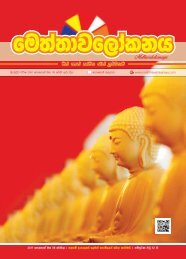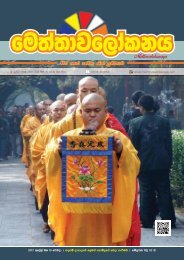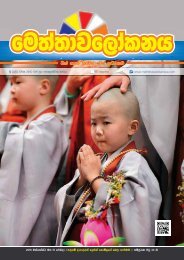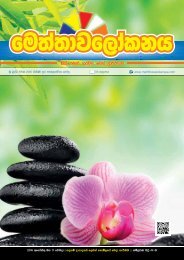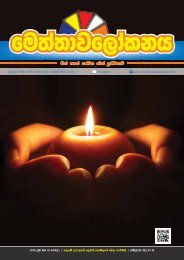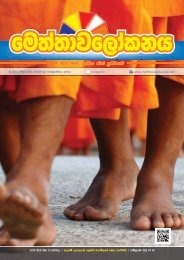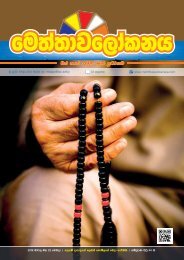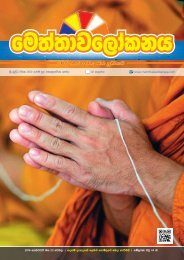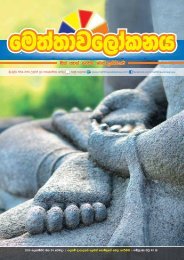Mettavalokanaya Buddhist Magazine - December 13 2016
Sri Lankan most popular & leading Buddhist Magazine “Mettavalokanaya” Buddhist Magazine - December 13 2016
Sri Lankan most popular & leading Buddhist Magazine “Mettavalokanaya” Buddhist Magazine - December 13 2016
Create successful ePaper yourself
Turn your PDF publications into a flip-book with our unique Google optimized e-Paper software.
The Seven Weeks After Enlightenment<br />
All <strong>Buddhist</strong>s as well as others are aware that after<br />
enlightenment Buddha spent the next seven weeks at seven<br />
different places. Pilgrims from all over the world come to<br />
Bodh Gaya and venerate the seven places by offering flowers,<br />
lighting oil lamps, incense sticks and reciting stanzas. Yet how<br />
many are aware of the inner true meaning of the seven weeks<br />
the Enlightened One spent after enlightenment? The stanza<br />
says,<br />
The First Week - At Bodh Gaya pilgrims who visit will<br />
pay homage to the Bodhi Tree by offering flowers, lighting oil<br />
lamps, burning incense sticks and recitation of the stanzas.<br />
They will also worship the seat at the base of the tree stated to<br />
have been used by Buddha. However the great majority would<br />
limit their veneration to the ritual aspects without trying to<br />
fathom the depth of the occasion or the inner understanding<br />
of the actual situation. It is also customary for devotees to<br />
observe the eight precepts while venerating the seven places.<br />
It is stated that after enlightenment Buddha stayed the<br />
first week at the base of Bodhi (BODHI MULE NISIDATHI). What<br />
is the base of Bodhi, is it the base of the Ficus Religiosa tree?<br />
To understand, we need to delve deeper into the Dhamma.<br />
At the end of the first week, on the final night Buddha in the<br />
first watch delved into the co-dependent origination. Then<br />
he saw that all things (Dhamma) are dependently originated.<br />
When this is there this arise, when this is born this is born.<br />
In the middle watch he noted that all things, when this is<br />
not there this is not there, when this is ceased this ceases. In<br />
the morning watch he introspected in both the forward and<br />
backward directions simultaneously, this arises when this is<br />
there and this ceases when this is not there.<br />
Then Buddha uttered these stanzas, “To the Brahmana<br />
(the Arahath) who is meditating with energy, to him there<br />
it arises that all things arise because of a cause - To the<br />
Brahmana who is meditating with energy, to him there it<br />
arises that when the cause is not there the resultant too is not<br />
there - To the Brahmana who is meditating with energy will<br />
disperse away the ten armies of Mara just as the morning sun<br />
will brighten up the dark sky.”<br />
This in itself is the essence and the basis of codependent<br />
origination. We worldly people know to recite<br />
the 12 resultants arising from the dependent causality.<br />
Those are the results but here on the first week after<br />
enlightenment the Enlightened One dwelled on the<br />
very principle of co-dependent origination. In other<br />
words this is the very base of knowledge (Bodhi). Thus<br />
it should be seen that the Buddha in the first week after<br />
enlightenment dwelled looking at the very base on<br />
it all, co-dependent origination. Thus we say<br />
BODHI MULE NISIDATHI seated at the base of<br />
realization, the co-dependent origination.<br />
The things or Dhamma are the 12 things<br />
in the co-dependent origination (Patichcha<br />
Samupppada). To the Brahmin (the Buddha<br />
or Arahath) who is meditation with energy<br />
and strength it becomes fully clear that the<br />
12 things or Dhamma that arise are purely<br />
on the basis of co-dependency<br />
principle. Indeed, when a person<br />
becomes a stream enterer (Sothapanna), the person realizes<br />
this foundation, “Yan kinchi samudaya dhamman, sabbanthan<br />
nirodha dhamman”, that the twelve things as evident in codependent<br />
origination arise and cease.<br />
“ITHI IMASMIN SATHI, IDAN HOTHI, IMASSA UPPADA<br />
IDAN UPPAJJATHI”. When this is present this arises, when this<br />
is born, this is born. In short it all happens then and there. This<br />
is different to the modern science where it is about when this<br />
is there, that arises.<br />
The Second Week - The location where Buddha spent<br />
the second week after enlightenment is in the area in front<br />
of the temple, to its left. This week it is said that the Buddha<br />
spent whole week looking at the Bodhi Tree without blinking<br />
his eyes. In the veneration of Dhamma the stanza speaks of<br />
wise realizing this Dhamma through self. Thus here too we<br />
must dwell deeper into the situation.<br />
In explaining the conditioned in Dhamma it is stated,<br />
“Bhikkus, the conditioned have in it these three, what are<br />
these three? There appears arising, there appears ceasing and<br />
what is seen as permanent there is this and that”. This means<br />
that in the conditioned even this permanence visualization is<br />
a case of being this and that simultaneously or in other words<br />
this constant change and not permanence. It is also said that<br />
this arising and ceasing (birth & death) occurs faster than the<br />
blinking of the eye. Buddha is one who is beyond birth and<br />
death and during this week it can be seen that he was delving<br />
into the realization or the enlightenment. Thus the Buddha<br />
spent the second week in the realization of Nibbana where<br />
there is no birth or death. Thus we say the second week he<br />
spent in expression of his gratitude to the Ficus Religiosa<br />
tree which gave the shelter. From a deeper perspective it can<br />
clearly be understood that Buddha spent the second week<br />
in the super mundane aspect of the Nibbana of no birth or<br />
death.<br />
Suppose an eminent scientist finds something new<br />
after much research, he or she will delve into that again<br />
and again to relook at it. In the same way it can be seen<br />
that Buddha too looked into his self realization of the<br />
truth. It is also stated that given the deep and profound<br />
nature of the realization, the Enlightened One once did<br />
wonder whether the worldly people would be able to<br />
understand such a profound and deep truth.<br />
Third Week - The location where the Buddha<br />
spent the third week after enlightenment is seen<br />
to the left of the temple. It is said that in the third<br />
week Buddha with his omniscient knowledge created<br />
another Buddha and the two of them walked<br />
in the opposite direction to each other.<br />
This means that both the Enlightened<br />
One and the created Buddha walked<br />
alone in direction opposite to each<br />
other.<br />
What is the inner super mundane<br />
significance of this? To understand the<br />
higher significance one must dwell<br />
into the “DWAYATHANUPASSANA<br />
SUTTA”. This person together<br />
with the second person of<br />
14 fu;a;djf,dalkh I foieïn¾ I <strong>2016</strong><br />
www.meththawalokanaya.com




